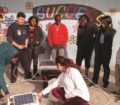 KEVIN BUMGARTNER
KEVIN BUMGARTNER
Truckee Meadows Community College
Mentors: Umakanta Jena, Desert Research Institute
Bill Gallegos, Truckee Meadows Community College
Hydrothermal Carbonization of Pinyon-Juniper (P/J) Biomass
Biomass has great potential for production of renewable fuels and chemicals. Biomass includes, wood, forest residues, crop residues, energy crops, animal manure, sewage sludge, and algae. Pinyon-Juniper (P/J) is an invasive woody biomass that grows naturally in the U.S. west coast, including Nevada. There is an opportunity to use P/J for biofuel purposes. Hydrothermal carbonization (HTC) is a unique thermal conversion process that involves pressure cooking of biomass at 175-275oC into a solid fuel, called hydrochar. Hydrochar has generally higher energy content and less oxygen content than the raw biomass and can be co-fired in power plants to generate heat and electricity. HTC of biomass involves high temperature (hence, high pressure), which raises the question of whether or not carrying out the reaction yields more energy than is put into it. The goal of the current research is to evaluate the HTC of P/J biomass and gather data that can be used to answer the above question; characterize HTC products at various experimental conditions and compare with the raw biomass. HTC runs will be performed using bench reactors (batch-type) at the Bioenergy Laboratory of the Desert Research Institute. The conditions of the various HTC reactions will be between 175°C and 275°C, and from 15 minutes to 30 minutes in duration. Data collection and analysis will include: product yields (hydrochar, gases and water soluble products), product composition, properties of hydrochar (CHNSO, energy content, ash content). A mass/energy balance for HTC will be evaluated from the above data, so that all energy and mass put into the reaction is accounted for upon its completion. Also, pelletization and drying of the hydrochar will be contrasted with pelletization and drying of the raw feedstock to a usable degree, to determine how much energy is saved in that respect. Quantities of energy required to dry the materials will be determined using a solar-powered dehydrator at DRI. The study is proposed to be completed between June 02- August 08, 2014. The HTC experiments, products analysis, and drying will be performed in the first 8 weeks. The final two weeks of the ten-week experiment will be dedicated for data analysis and synthesis/reporting. HTC of P/J biomass, if viable and used on a commercial scale for power production, might create an economic incentive for the management of this ecologically harmful invasive species from Nevada’s landscape, while reducing dependence on fossil fuels (coals).




